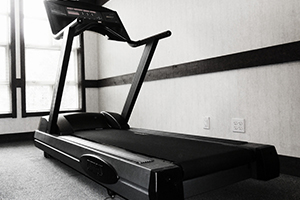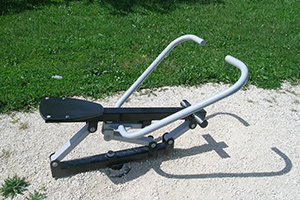Need a mat for your home gym? Here’s what you need to look for if you have a treadmill, a rower or a general home gym.
If You Own a Treadmill
Treadmills are large pieces of fitness equipment. They’re loud, and they’re heavy. All of these factors can work against you if you don’t protect your home’s flooring.

Without a good mat, the treadmill could easily puncture or shred your carpeting. Treadmills can also leave scuff marks, scratches, dings and holes in hard flooring, according to LiveStrong.
If you live in an apartment or your treadmill is on the second floor, The Rubber Floor Experts explain that a mat will help reduce noise and vibration (another serious bonus).
So, how do you choose a mat for your treadmill? Here are some things to consider:
Bigger Size
Treadmills are larger than most pieces of fitness equipment, so you’ll need to find a mat that will fit underneath your machine.
There are mats designed and marketed for treadmills, which typically have the right dimensions for standard machines. Still, it’s important to check the dimensions of your treadmill to make sure you choose a mat that’s wide and long enough.
The most common treadmill mat sizes include:
- 8′ x 3′
- 5′ x 3′
- 1′ x 5′
- 5′ x 3′
You’ll also find that some mats come in puzzle-piece form, so they connect together to create a custom-sized mat.
Larger Thickness
A thin mat will do little to protect your flooring if you have a big, heavy treadmill. If you plan to place a mat under your machine, you need to make sure that you choose an appropriate thickness level.
If your machine is sitting on a carpeted surface, mats that are 1/2″ to 3/8″ (or thicker) are ideal.
If your machine is sitting on hard flooring, you can get away with buying a thinner mat, but a thickness of at least 1/4″ is preferred.
If you happen to be on the heavier side or your treadmill is massive, a mat that’s 3/4″ thick may be better.
Gripping Surface
If your treadmill sits on hard flooring, you need a mat with a gripping surface. A gripping surface will prevent the machine from sliding and jerking around while you run.
Rubber mats naturally have a gripping surface (Inside Racing Technology explains why), but other materials may have a textured or pebbled surface that helps create friction.
Material type is really more of a personal preference here. The gripping surface is what really matters. Otherwise, your machine will move all over and you may wind up getting hurt.
If You Own a Rowing Machine

Rowing machines offer a great full-body workout, and unlike treadmills, there’s less to worry about when it comes to damaging your floors because they’re not quite as heavy.
Still, rowing machines can damage your carpet or hard flooring if you don’t protect it with a mat. There are many things to consider when choosing a mat for your machine.
Narrow Width
Rowing machines aren’t quite as wide as treadmills, so look for mats with a narrower width. The Concept 2, for example, has a width of just 24.”
The narrower design makes it much easier to find a mat that will fit underneath your rower. But keep in mind that these machines are longer than most other fitness equipment.
Many brands create mats just for rowing machines, so you can find one that’s just the right size for your machine. Just be sure to measure the dimensions of your rower before buying a mat, so you know exactly what you need.
Mat Material
The material of the mat is important. Unlike with a treadmill, which covers most of the mat and is far beneath you, rowing mats are just a foot or two beneath your feet. This means that if the mat has an off-putting smell, it can disrupt your workout or even cause health issues.
PVC is a great inexpensive option, but these mats often have an unpleasant smell.
Many users prefer rubber mats because they don’t have a strong odor, but you’ll also find some companies offer mats made of eco-friendly foam material. Many companies make their mats using recycled rubber, which is another environmentally-friendly option.
Here’s a video that explains how recycled rubber is made:
Along with the material type, you need to consider whether the mat has a textured surface, which will keep the machine in place during use.
For General Use
Fitness mats make your home gym a safer place, but how do you know which one to choose? Consider the following:
Solid or Puzzle?
Gym mats come in both solid and puzzle forms, which gives you plenty of options. Puzzle mats allow for a customizable size, while solid mats give you a seamless look.
The right option for you will depend on the size of the room. If you have a large space or awkward corners, a puzzle-style mat may be the better option.
Thickness and Material
Thickness and material are also important, especially if you use free weights. You need mats that are thick enough to absorb the impact of heavy weights hitting the ground.
Look for mats that are at least 1/2″ thick to absorb the impact of your weight (when exercising) and weights if they should hit the mat. The Iron Company explains that the 1/2″ thickness is more robust than thinner mats.
